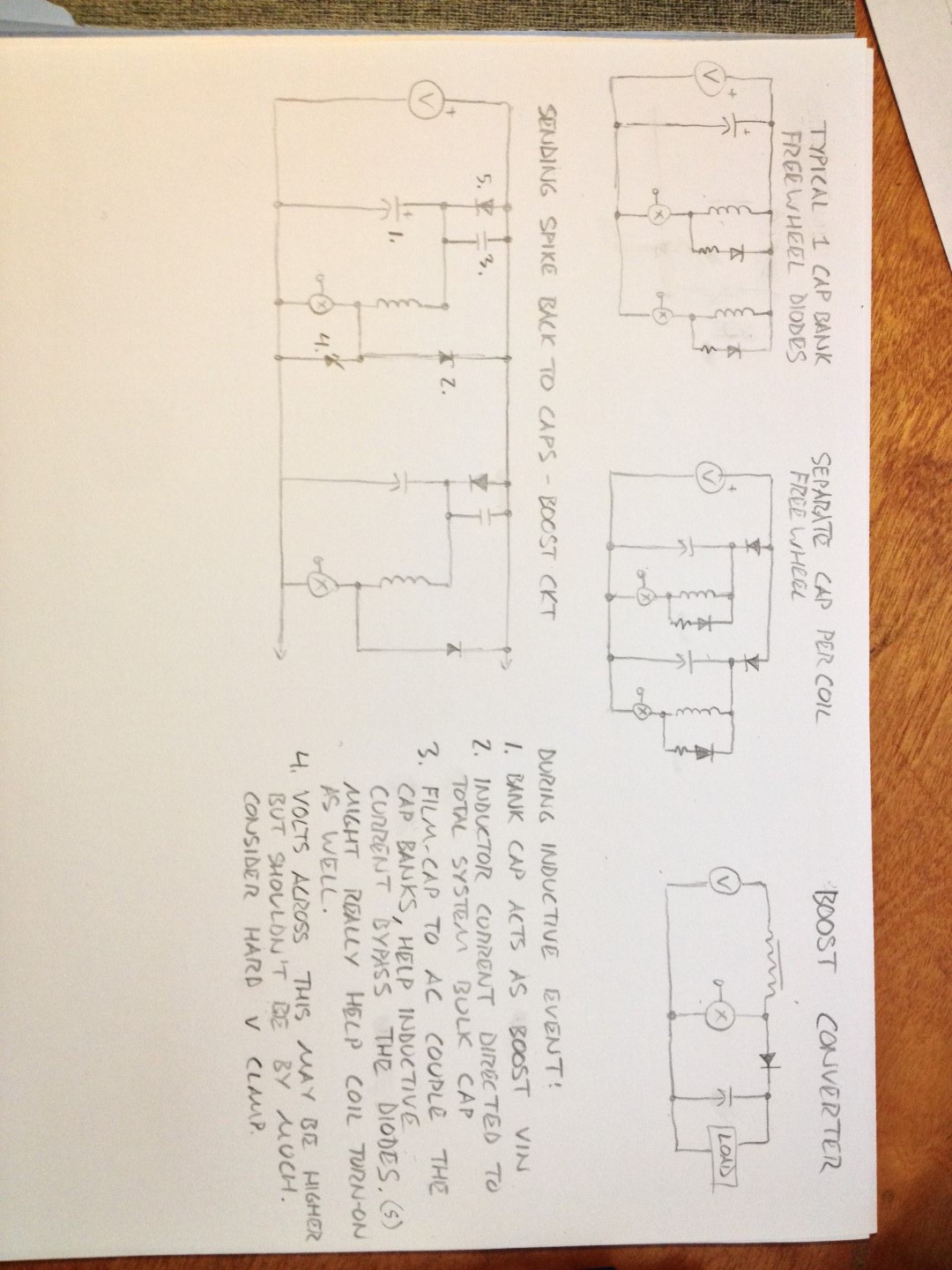-
A thought about inductive spikes
05/03/2014 at 19:50 • 1 commentSo, the typical solution to dealing with the massive voltage spike which occurs when the coil turns off is to put a freewheel diode across the coil. This shunts all of that reverse energy through the diode, and whatever resistances are in the circuit. Series R can be used to share that energy, it can be a lot for the diode to handle. In the case of a dry fire, plan on 100% of the charged capacitor bank energy bouncing right back out of that coil. Wouldn't it be a better idea to steer that energy into capacitors instead of shorting it through a diode?
The current plan involves multiple stages, and each stage will have it's own capacitor. They are separated by diodes, so that firing a coil does not discharge the cap for the next stage. What I realized is that all I need to do is simply move the diode location, and that coil will act as a boost converter, pumping current into all of the capacitors. In this arrangement I'm considering that additional voltage protection in the form of a hard clamp (drawn as zener diode) may be necessary. I may also decide to add protection diode across the switch (redundant to the FET body diode, also somewhat redundant to zener) and perhaps even one across the cap to make sure it does not receive negative charge from the inductor and that all of the juice makes it out as a positive charge. Sounds ridiculous at first but the load is a lot stiffer than the source here and the cap will be discharged.
I'm also adding film caps across the charge diodes. This should be enough to pass the high current spike through to the cap banks and not have to use large diodes here, but I'm on the fence on if this is a good idea. This will also cause a very low ESR rush of current when the switch first turns on, squaring up the turn-on waveform of the coil somewhat. It sounds like a good thing but it also means that the current spikes and noise won't be compartmentalized to each coil anymore. A extra filter on the output of my charge converter might make it all good? I'm probably over-analyzing what amounts to slapping an RC snubber in there.
What I'm more concerned with is that the entire bank of caps will pump-charge itself and then I have an overvoltage condition on the entire system, particularly in the case of dry-fire. How realistic of a problem is this? Well, as long as the charge converter is not running then voltage should get settled back down into the discharged caps and things average out.
This led me to a complete brainstorm idea. Can I actually use this as the boost converter to charge itself from battery voltage?? Why add more coils and switches if I already have these? I'm not seeing how to pull it off yet but it's on the burner..
edit:
http://www.coilgun.eclipse.co.uk/diode_commutation_experiments.html
There is a concern that squashing current in the coil as fast as possible is a good idea as letting it linger in there can retard the projectile speed. If this is the case then I would be better off putting a huge freewheel diode or perhaps even an active clamp in there. Once I have a coil made it will be easy enough to experiment.
I'm hoping to negate the issue by calculating the speed the projectile will be at for each stage, and setting up the inductance for each coil so that the pulse duration is timed accordingly. Because the coils will be physically short, the projectile should be gone for the freewheel ringing garbage phase of the pulse. This of course goes out the window for lower-power shots or using heavier ammo.
-
Stage 1: Power
04/29/2014 at 02:29 • 0 commentsWell, you have to start somewhere. In this case I had to decide on a power level, and the ammo.. and just started calculating from there.
1/2" ball bearing ammo
160J
Some caps scavenged from dumpster: 560uF 450V
Internet sourced efficiency expectation: 6%
24 stages. 33" long barrel. 6" tall. It will be bulky but it's shaping up to be possible.. I'm not ready to share my spreadsheet of massive calculations but at this point I've got it spilling out inductance goals for each coil stage.
Where it gets interesting is the power system. Higher voltage will pack more punch, so I'm shooting for 900V. A custom boost converter is in order to step up the battery voltage to and adjustable output of up to 900V, and it's going to be spending the whole time in current limit pumping up a purely capacitive load.
The battery pack I have lined up are some LiPO4 cells strung up to 48V. 10A continuous, 100A for less than 30s. So right there I'm looking at 480W continuous 4800W peak. So, obviously we won't be using a flyback out of a disposable camera. This will have some meat to it.
I plan on handling those batteries with kid gloves, it will have it's own separate power handler for current limit, undervoltage limit/shutdown, thermal limit/shutdown, and charging.
Charging will come from the AC when it's plugged in. The AC will be limited to 1500W/15A, so again another current limiting. Where they all tie in will be a sort of soft buss where each system is just putting in what it can while watching it's own back.
160J Coilgun
A multiple stage coil gun with an adjustable output goal of up to 160J.
 dave.m.mcdonough
dave.m.mcdonough